Moyeu de roue de vélo électrique en composite recyclé
COGIT Composites parait dans le JEC Magazine « spécial mobilité » de mai 2020. COGIT y présente des travaux sur le recyclage et le ré-usage de composite thermoplastique pour une application « verte » de moyeu de roue de vélo électrique.
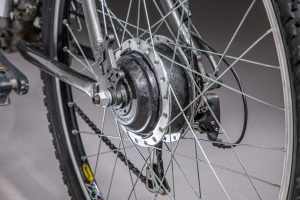

Lien vers la page web du JEC :« How it’s made? … »
Pour les abonnées, voici le lien vers l’article complet du JEC Magazine n°133
Extrait de l’article intitulé « ELECTRIC BIKE WHEEL HUB WITH RECYCLED COMPOSITE » :
Keywords: Electric bike, Recycling, Thermoplastic Composites, Carbon fiber
JEC Composites Magazine – special issue – Mobility
The use of thermoplastic polymers as matrix materials in long-fibre composite materials is increasing. This implies more production scrap in the short-term and more end-of-life parts in the long-term to be dealt with. Today, there is no easy way to separate carbon fibre from its matrix in unused composite material. So, those wastes were meant to be buried or burnt. This would have lead to generate toxic fumes, greenhouse gases or water and soil pollution. To best comply with the latest EU regulations, such as the Waste Framework Directive [1] and the Directive on End Of Life Vehicles [2], recycling and re-use must be integrated into development plan.
In plastics industry, the usual recycling method is a shredding step followed by a grinding step, giving a finer material which serves afterwards as reinforcement in thermoplastic injection processes. Unfortunately, this leads to low reinforcement level compared to the initial part. An alternate solution is to chop the composite parts or the production scrap [fig.1] into not-so-small compound [fig.2] such as 25-50mm length and 2-6 mm width and use it as primary material in Compression Moulding process.
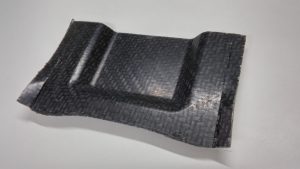 Figure 1: Stamped part
Figure 1: Stamped part
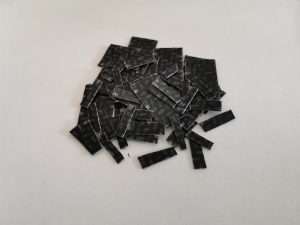
Figure 2: Chopped composite
For 15 years, COGIT Composites has defined those thermoplastic composites and their processes as its main strategy. Working at Compression Moulding, Stamping and over-Injection/moulding, especially for aeronautic applications, we soon thought we could use our advanced skills to produce parts that require the same level of quality but on a totally different field such as medical, luxe or sport products. The aim wasn’t to manufacture just simple products but to be eco friendly. So the decision had been taken to use wastes of production to reduce the foot print of daily mobility. That’s the way a new electric bike wheel hub had been developed.
A specific design had been created to replace existing aluminium part [fig.3] to a lighter wheel hub [fig.4] while ensuring complex shape forming, structural and kinematic functions and also a high-end perception to the final customer.
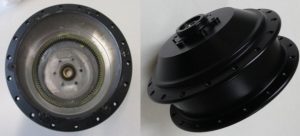
Figure 3: Main body of Aluminium Wheel Hub
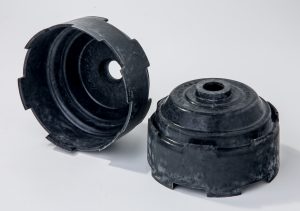
Figure 4: Main body of re-used composite Wheel Hub
At starting point, the team applied Compression Moulding design rules so as to evaluate the technical feasibility and properly integrate original functions and more. Parallel to this engineering stage, a collaborative R&T project called RTL3 (2012-2015) had been conducted with University of Orleans and Plasticompo platform in the centre of France. The goal was specifically to define which compound’s size is the best to be used comparing mechanical strength and ability to be processed. For instance, the investigated parameters were grain or pellet sizes and their distribution into the mould at the beginning and at the end of the compression process. Design of experiments, mechanical characterization and tomography inspections gave scientific approach [3] so as to bring a better knowledge of random material properties into a complex part.
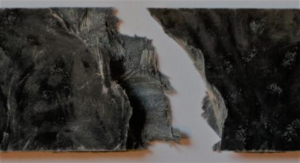
Figure 6: Typical fracture between aggregated grains
From this experience, COGIT Composites had kept on studying other raw materials such as carbon/PA and carbon/PEEK. These research enlarged overview of processing parameters and mechanical properties depending on matrix.
….
Finally, the main key benefits of this wheel hub [fig 7] are the re-use of production waste, the valuable perception of high performance material and the short cycle recycling dedicated to green mobility. The eco-design shouldered by scientific and experimental support becomes a real advantage to customer. Indeed, the finish given by the forged carbon adds value to the final electric bike [fig 8].
References:
[1] European Bioplastics, Fact Sheet, Mechanical Recycling, Waste framework Directive, 2008/98/EC, Article 11: Re-use and recycling (2010).
[2] EU, Brussels. End of Life Vehicle Directive 2000/53/EC (2000).
[3] J Moothoo, C. Garnier and P. Ouagne, Mechanical properties of compression moulded aggregate-reinforced thermoplastic composites scrap – 2015
